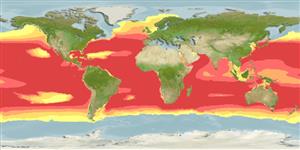Common names from other countries
Environment: milieu / climate zone / depth range / distribution range
Ecologia
marino batipelagico; oceanodromo (Ref. 51243); distribuzione batimetrica 0 - 1050 m (Ref. 44036). Deep-water
Eastern Atlantic: Morocco to Namibia (gap over region of cyclonic gyre 4°-6°S). Western Atlantic: USA to Subtropical Convergence, [but absent over minimum region off Brazil according to Ref. 4479] and lower abundance in Sargasso Sea. Also in the southern Indian Ocean, North and South Pacific (absent in equatorial waters). South China Sea (Ref.74511).
Length at first maturity / Size / Peso / Age
Maturity: Lm ?, range 5 - ? cm
Max length : 6.0 cm SL maschio/sesso non determinato; (Ref. 4479)
Spine dorsali (totale) : 0; Raggi dorsali molli (totale) : 13 - 15; Spine anali: 0; Raggi anali molli: 21 - 25; Vertebre: 38 - 40. Branchiostegal rays: 8-9 (Ref. 31442). Anal organs 14-15; males with single supracaudal gland filling about 1/2 the supracaudal space, females with 3 coalesced infracaudal gland patches, sometimes separate (Ref. 39633).
Oceanic, found below 1,000 m during the day and from the surface to 200 m at night (Ref. 4479). Neustonic to mesopelagic (Ref. 58302). Oviparous, with planktonic eggs and larvae (Ref. 31442). Lipid content is 3.3 % in fresh body weight and wax ester is 10 % in total lipids (Ref. 9197). Reach sexual maturity at 4,6 cm (Ref. 47377).
Hulley, P.A., 1990. Myctophidae. p. 398-467. In J.C. Quero, J.C. Hureau, C. Karrer, A. Post and L. Saldanha (eds.) Check-list of the fishes of the eastern tropical Atlantic (CLOFETA). JNICT, Lisbon; SEI; Paris; and UNESCO, Paris. Vol. 1. (Ref. 4479)
IUCN Red List Status (Ref. 130435)
CITES (Ref. 128078)
Not Evaluated
Threat to humans
Harmless
Human uses
Strumenti
Special reports
Download XML
Fonti Internet
Estimates based on models
Preferred temperature (Ref.
115969): 8.6 - 20.6, mean 13.7 (based on 1088 cells).
Phylogenetic diversity index (Ref.
82804): PD
50 = 0.5020 [Uniqueness, from 0.5 = low to 2.0 = high].
Bayesian length-weight: a=0.00692 (0.00297 - 0.01609), b=3.13 (2.93 - 3.33), in cm Total Length, based on LWR estimates for this (Sub)family-body shape (Ref.
93245).
Trophic level (Ref.
69278): 3.2 ±0.31 se; based on food items.
Resilienza (Ref.
120179): Alto, tempo minimo di raddoppiamento della popolazione meno di 15 mesi (Preliminary K or Fecundity.).
Fishing Vulnerability (Ref.
59153): Low vulnerability (10 of 100).
